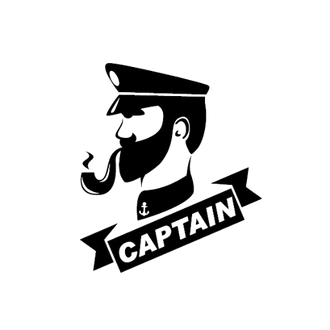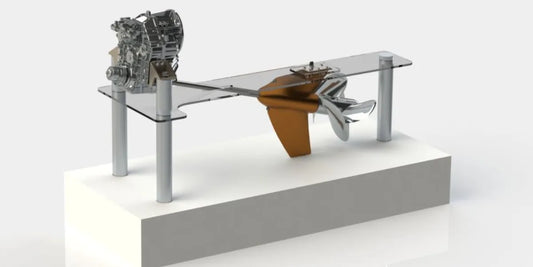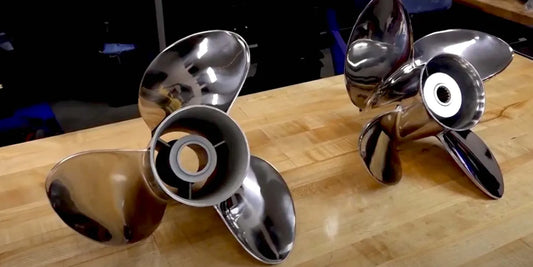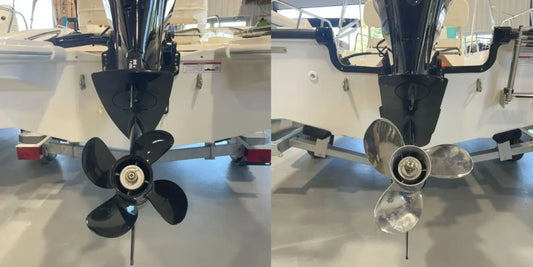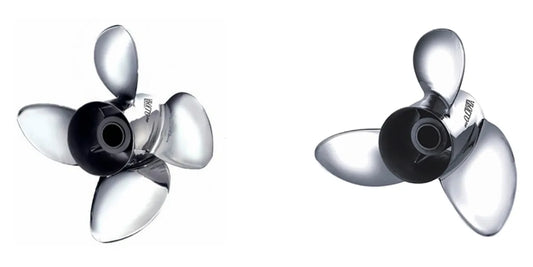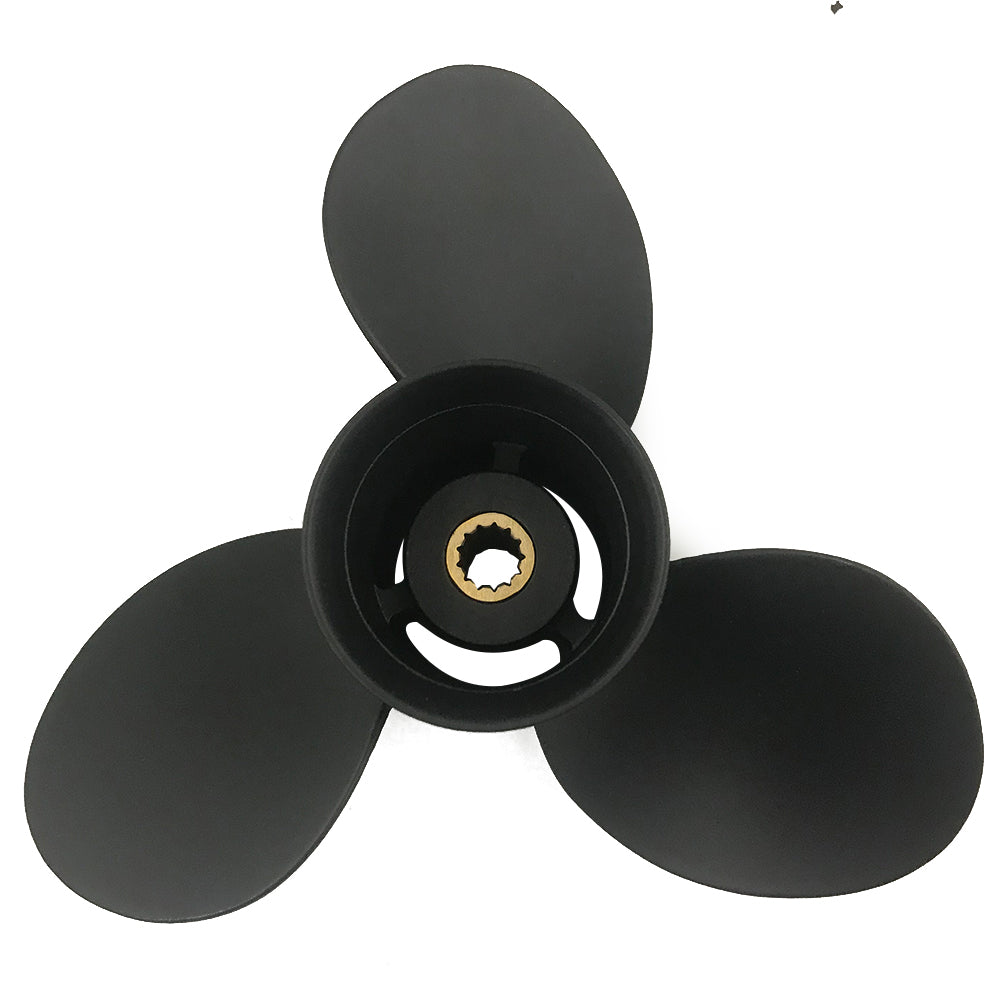Propeller selection ranks alongside engine and hull choice in importance for boating enthusiasts. Stainless steel props are among the strongest, most efficient, and most reliable, giving sailors plenty of reasons to trust them. This guide reviews the most critical differences between 4-blade and 3-blade stainless steel propellers so that you can make the most informed choice for your boating needs. Understanding each prop’s unique qualities allows you to select between enhanced control, speed, or fuel efficiency, all while boosting your boat's performance.
What are the advantages of a stainless steel propeller over aluminum?

How does a stainless steel prop improve performance?
The performance of a boat equipped with a stainless steel propeller will benefit from its efficiency and durability. Here are some advantages:
Performance in Harsh Environments: Damage resistance of stainless steel provides the advantage of being significantly more potent than aluminum. Bending and cracking are less likely to happen, which increases long-term reliability and performance when traversing damaged waters filled with debris.
Increased Blades Efficiency: More rigorously engineered blades that are thinner due to the strength of stainless steel allow for lower water resistance, increasing efficiency.
Top Speed Improvement: Optimized blade design combined with reduced flex improves energy transfer from the engine to the water, allowing for much higher top speeds than aluminum propellers.
Enhanced Acceleration Responsiveness: Stainless steel's rigidity allows for reliable performance during sharp maneuvers and sudden acceleration, which increases handling and responsiveness.
Decreased Fuel Consumption: Improved fuel economy can result from blades needing less fuel due to more precise blade shapes reducing drag.
Due to these unique parameters, stainless steel propellers will greatly benefit boaters seeking to maximize performance significantly in high-powered applications or demanding conditions.
Are stainless steel props more durable than aluminum?
Yes, due to their material characteristics, stainless steel propellers are usually more durable than aluminum, and here is the list of technical parameters that support this:
Material Resistance: For comparison purposes, stainless steel has greater tensile strength than aluminum, making it more resistant to deformation/breakage under high stress/impact.
Corrosive Attack Resistance: Both materials are corrosion-resistant, but stainless steel performs best in saltwater environments because of its corrosive-resistant nature.
Abrasion Resistance: Erosion from sand, debris, or water currents is less likely to wear away stainless steel, enabling its use in harsher conditions for a longer timeframe.
Resistance to Flexural Deformation Under Load: Compared to aluminum, stainless steel has a higher modulus of rigidity, which prevents flexing under high-speed rotation and heavy load, thus ensuring performance.
Stainless steel is a reliable choice among boaters operating in harsh environments or those requiring maximum durability within twelve nautical miles.
Will a stainless steel propeller increase my boat's top speed?
One of the main reasons stainless-steel propellers are increasingly popular is because they can potentially increase a boat’s speed. Steel propellers are thinner and more rigid than their aluminum counterparts. This enables them to perform better hydrodynamically, as more power is transformed from the engine into propulsion, and drag is significantly lowered. The following points justify to support this claim:
Material Rigidity: Because stainless steel is rigid, it guarantees that the propeller's blades will remain in their intended form during high-speed motion, thus enhancing thrust due to less distortion.
Blade Design: Many stainless-steel props have advanced blades, including precision cupping and rake angle features, which increase the boat's speed and acceleration.
Optimal Pitch: A proportionately matched pitch guarantees that the engine's peak RPM is achieved without straining it, which further increases speed.
Reduced Drag: Blades made of stainless steel have thinner and more streamlined propellers, which causes drag in the water to decrease during motion and increases top-end performance.
Optimizing these features can help increase a boat’s top speed; however, factors like engine power, hull design, and overall load are just as crucial. Balancing the propeller’s specifications and the boat's performance parameters is essential for enhanced efficiency.
How do I choose the right stainless steel prop for my boat?

What factors should I consider when selecting a stainless steel propeller?
Different factors should be considered when looking at a stainless steel propeller. Here are the most important:
Propeller Size – Make certain that the prop's diameter and pitch are appropriate for your engine and boat. Recall that pitch determines speed and acceleration, while diameter dictates thrust and handling. Consult your engine manufacturer for sizing guidance.
Number of Blades – While three-blade propellers are ideal for speed and efficiency, better control, and smoother performance in rough waters or when carrying heavy loads, four-blade propellers are better suited.
Rotation and Design – Establish if your boat needs a right or left-hand rotation propeller, depending on how the engine is positioned. Also, blade design elements like the rake and cupping, which influence lift and grip, should be considered.
Boating Application—The propeller must suit the boating activity. A prop for a high-speed application may need more pitch, whereas quicker towing or handling of heavy loads might require a lower-pitch prop.
Material Advantages – Unlike aluminum props, stainless steel ones, which are resistant to high deformation, are much more durable and thus outperform them in terms of performance.
A good consideration of these parameters will enable you to select a stainless steel propeller that meets your requirements in terms of performance and makes it more enjoyable for you to use the boat. Always contact a marine expert for particular advice.
How do I determine the correct diameter and pitch for my boat?
Getting the accurate diameter and pitch for your boat requires fully comprehending their performance impact on efficiency:
Diameter—This is the propeller’s size, which is ideally selected based on the engine and the size of the boat. Whether the ship is large or the load has substantial weight, a propeller with a large diameter must produce a powerful thrust. On the other hand, smaller boats with less resistance benefit from a smaller diameter because the response is quicker and more efficient.
Pitch – The distance a propeller would have advanced in one full rotation is known as a pitch if there was no slippage in the engine. With the ability to increase speed, a higher pitch could pose problems during acceleration as it would take a toll on the engine. In comparison, lower pitch improves acceleration better than higher ones in motorboats but poses difficulties in maximum dialed speed.
Right Combination:
Choose a propeller with an engine manufacturer’s recommended RPM (Revolutions Per Minute) range that matches yours, usually found in the user’s manual.
Conduct a WOT (Wide Open Throttle) test. The ideal propeller should engage the engine in maximum throttle, moving towards the suggested WOT RPM, and might require full power.
Focus on your boating activities—cruising, fishing, or towing— to enable speed or power optimization.
Balance the propeller's pitch and diameter, yielding the best performance and fuel consumption and prolonging the engine's life. If you have any doubts, contact a marine expert.
Should I choose a 3-blade or 4-blade stainless steel prop?
Which type of propeller to go for, a 3-blade or a 4-blade stainless propeller, depends on what activity you would like to do and how performance-driven you are. Here's a simple layout:
3-blade stainless steel propeller:
Speed and Efficiency: For maxed-out drag wins, it is ideal for recreational boating or water skiing.
Acceleration: Nice acceleration using higher RPMs.
Handling: Great handling and maneuverability.
Bets for: Lighter boats or if speed and fuel efficiency are priorities.
4-Blade Stainless Steel Prop:
Power and control: Low-speed handling is better for increased stability and smoother sailing on rough waters.
Hole Shot: Great for towing with wakeboarding or other hard-hitting activities.
RPM: Usually propagates at a slower RPM compared to a 3-blade prop and does lose some top-end speed, so expect that.
Best For: Heavily loaded boats for towing or if slow speed stability and maneuvering are critical.
Choosing the correct prop takes some in-depth calculations, such as the weight of the boat, engine specs, and what you want to achieve. The impact-proven blade number involves acceleration, velocity, and efficiency, meaning you must rely on the primary activities and the surrounding conditions. If you want to play it safe, try both blended and taken to a marine professional to determine your sailing needs.
Are stainless steel props compatible with all outboard motors?

Can I use a stainless steel prop with my Yamaha outboard?
Indeed, you can use a stainless steel prop with your Yamaha outboard if it meets the specifications of your engine model. Unlike aluminum props, stainless steel props are much stronger and better for acceleration and top-end speed. That said, here are some other important factors to keep in mind.
Propeller Diameter and Pitch: These two factors must be within the range specified by Yamaha for your engine so that the motor is not put under unnecessary strain.
Blade Design and Count: These must be tailored to your primary use. Higher speeds require fewer blades, while more control in choppy waters requires more blades.
Hub Compatibility: The prop should also have a hub system accommodating your Yamaha outboard shaft.
Before purchasing, consult Yamaha’s books or a maritime professional to check these values.
Do Mercury outboards require specific stainless steel propellers?
Truly, stainless steel propellers must be fitted to attain proper performance from the refrigeration outboards. When choosing a propeller mercury outboard, consider these specialized features-
Pitch: Select a pitch tailored to the desired speed and engine performance. A higher pitch means more incredible top-end speed; a lower pitch means better acceleration.
Diameter: Choose a diameter within the weights recommended by mercury so that it efficiently pushes the required amount of water for your size and type of boat engine.
Number of Blades: Having fewer blades is excellent for speed control; more control requires more fantastic blades, especially in rough waters.
Hub System Compatibility: Check that the propeller's hub system is compatible with Mercury’s propeller drive shaft. The propeller should fit into the shaft and not damage the rotor during use.
Material and Finish: These should be stainless steel as they are durable and less prone to corrosion, especially in salt water.
For each outboard engine model you choose, always check with Mercury’s manual or speak with a marine technocrat.
What about Suzuki and other outboard motor brands?
Like Mercury motors, key principles are applied when selecting Suzuki or other outboard motors. Below are pointers to help you achieve seamless performance and compatibility:
RPM: Check Suzuki’s specific motor model and WOT’s recommended RPM range. Unlike other brands, the propeller must allow the engine to reach Suzuki’s RPM range, or the motor will frequently become overstrained and inefficient.
Pitch: A propeller with a lower pitch provides an increase in thrust, which is helpful while towing heavy weights. On the other hand, a propeller with a higher pitch can enable more incredible speeds to be achieved, but at the cost of more power from the motor.
Blades: Suzuki outboards offer multi-blade propellers in various configurations. While fewer blades give better top speeds for propellers, more blades are better for calmer and smoother operability in choppy waters.
Hub system: Verify that your propeller selection has hub system features that match Suzuki’s drive shaft specs. Failure to do so will damage and wear the motor's components.
Material: Stainless steel is often preferred because of its durability and resistance to corrosion, while low-quality aluminum is also usable for less active leisurely motor use.
For the other brands of outboard motors, always follow the same procedures and seek advice from the specific manufacturer. Reading the user manual and getting help from a qualified boat mechanic can help you choose the right propeller for your engine’s technical specifications and performance needs.
How does a stainless steel prop affect fuel efficiency and RPM?

Will a stainless steel propeller improve my boat's fuel economy?
Yes, certain conditions under which your diesel boat will get better fuel economy with a stainless steel propeller. The rigid structure of stainless steel props allows them to deflect less than their aluminum counterparts. This improves efficiency with the achievement of thrust and reduction in energy loss. Furthermore, their accurate designs frequently enhance propulsion fuel economy due to better hydrodynamics.
Nonetheless, it is crucial to note that fuel economy relies on proper flow selection. Critical from the fuel economy perspective are the following propeller details:
Pitch—A well-pitched stainless steel prop helps enhance fuel economy by keeping the engine speed within the optimum range.
Diameter – Ensuring the diameter matches your boat's specifications enhances performance and limits unwanted resistance.
Weight – Unlike aluminum, stainless steel props are heavier, which may have a minimal impact on acceleration. However, the improved economy during cruising speed most compensates for this.
Appropriate prop selection will guarantee that the positive side of these parameters is achieved without negatively impacting engine performance.
How does a stainless prop impact engine RPM?
Using a stainless steel prop instead of aluminum can affect engine RPM colossally. Since stainless steel has a more rigid and refined design, it flexes less when under a load than aluminum. Because of this, the engine will likely reach lower RPMs while operating at wide-open throttle (WOT). The most relevant technical dimensions are affected are:
Pitch: A stainless prop has a higher pitch and a more robust structure, which can lead to lower RPMs because the engine has to work harder to turn it.
Weight: The denser stainless steel can contribute to lower RPMs, especially in the initial acceleration stages.
Diameter: If the diameter is more precise or slightly larger than an aluminum counterpart, it may translate to lower RPMs as the prop moves more water with each revolution.
Considering these relationships helps select appropriate props for my engine RPM where I know it will function most efficiently.
What maintenance is required for a stainless steel boat propeller?

How do I care for my stainless steel prop?
To maintain my stainless steel prop, I check for any dents, cracks, or bends because, if left unchecked, these could result in poor performance and expensive repairs down the line. After every usage, I rinse my prop every single time. This is especially true after using it in saltwater so that I can thoroughly wash away any salt, grime, and debris that could cause corrosion over time. Excess fouling on my prop can lead to optimal thrust on my engine, which can put it under excess strain, so my prop must stay clean.
As part of my routine, I check for proper installation and tightness, as a loose or improperly installed prop can negatively affect several things, such as pitch and diameter, which leads to irregular RPMs or vibrations. Providing a protective anti-corrosion spray could maintain the surface finish to battle the harsh marine environment while ensuring reliable performance. It is critical to incorporate these maintenance habits to prolong the life of my stainless steel prop and ensure the effectiveness of my entire boating system.
Are there any special considerations for saltwater use?
Indeed, there is always an approach I have regarding the use of saltwater as a resource. In this case, saltwater is much more corrosive, one has to be careful on how best to protect the stainless steel propellers. It is also essential to thoroughly rinse all equipment and the boat with fresh water after using saltwater because salt residues will eventually lead to corrosion. Another step I take is the application of high-quality spray anti-corrosion that protects against humid and salty conditions.
Looking at it from a technical point of view, the damaging effects of prolonged exposure to saltwater can affect performance in the following ways: pitch, diameter of the propeller, and the finish on the surface of the blades. Because corrosion or pitting of the blades tends to reduce, the propeller's efficiency is lost because of disruption of the “smoothness” and the “balance” of the propeller, which causes excessive vibration and changes in RPM or thrust. Proper maintenance prevents these adverse effects, which protects my propeller and enables me to enjoy a smooth time on the water, even in harsh saltwater conditions.
Frequently Asked Questions (FAQs)
Q: What are the advantages of a stainless steel prop over an aluminum propeller?
A: Stainless steel merely outclasses aluminum propellers in several aspects, such as performance, durability, and drag. Unlike aluminum, stainless steel has better shape retention, enhancing speed and acceleration. In addition, stainless steel props outshine their rivals in performance and resistance to damage from debris in water.
Q: In what ways are the blades of stainless steel and aluminum props designed differently?
A: A strength-saving feature of stainless steel props is that they can be made with thinner, more efficient blades. This leads to acceleration, top-end speed, and fuel efficiency improvements. Furthermore, impressive features such as s stainless steel blades do not face limitations to variable rake and pitch blade designs which enhances overall boat performance.
Q: Do stainless steel props work for every boat and engine?
A: While the versatility of stainless steel props is prominent, they shine the most when used in high-performance boats and engines with high horsepower (hp). They are perfect for outboard motorboats ranging from 115 hp to 225 hp. That being said, the performance of these props greatly relies on intelligently pairing them with specific boats, engines, and purposes they are intended to serve.
Q: How do stainless-steel props influence trolling speed or slow-speed movements?
A: Due to their effectiveness at different rpm levels, stainless-steel props can offer enhanced control at low speeds and trolling. They are particularly optimized for low-speed operations and are great when fishing because they require precise speed control.
Q: Why is the hub of a stainless-steel prop important?
A: The hub is vital for every propeller, including stainless-steel props. Some stainless-steel props have a rubber hub, which can relieve some shock and protect the lower unit or gearcase from damage during impact. Some props have mixed hub kits, facilitating prop hub customization and making removing and replacing parts easier.
Q: What pitch do I select for my stainless steel propeller?
A: The pitch suitable for your application is essential for overall efficiency. Stainless steel props commonly have 17p, 19p, and other pitches. Your boat's length, weight and the purposes you intend to use it determine the most suitable pitch. A marine expert or a propeller expert can be of great use in determining the right pitch for your setup. They will be able to help you achieve the correct RPM range and performance level for your vessel.
Q: Which stainless steel propellers perform better: three or four blades?
A: The right choice will depend on your requirements. If you want faster fuel consumption at high speed, then the three-blade props will do just fine for recreational boating. Four-blade props perform best for acceleration, with added lift and better handling in rougher water. Some recommended three-blade props are 14x17 and 19 pitch, which perform well, but your vessel's features and intended performance will determine the best option.
Q: What is the impact of stainless steel props on fuel consumption?
A: Stainless steel props can improve fuel efficiency because they do not warp at high speeds, leading to less drag. Their precise design allows for good clearance, which, combined with the material's durability, translates to consistent performance over time and economy. Conversely, the wrong propeller, in terms of size and pitch, for the specific engine and boat combination will have the opposite effect on fuel economy.
Q: When stainless steel props are compared to aluminum props, do they justify the expense?
A: Although stainless steel props can be viewed as unnecessary because they cost more than aluminum propellers, their economic value can be justified through their benefits. Unlike aluminum props, stainless steel ones do not flex, offering better acceleration, top-end speed, and durability. Typically, stainless steel props are the appropriate option for boaters wanting enhanced performance while maintaining economic value.
Q: How should a stainless-steel propeller be cared for?
A: Isn’t it reassuring that caring for a stainless-steel prop is pretty straightforward? Simply rinse it with fresh water after every use, especially if it contains salt. Regularly check the blades for any signs of damage or wear. If there are any nicks or bends, ensure that they are fixed professionally for optimal performance. Also, ensure the prop is adequately greased and the hub is in reasonable condition. If maintained, a stainless steel prop can be helpful for many years.
